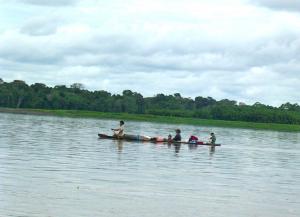The Kukama-Kukamiria Documentation Project

Landing page image for the collection “The Kukama-Kukamiria Documentation Project”. Click on image to access collection.
| Language | Kokama-Kokamilla |
| Depositor | Rosa Vallejos |
| Affiliation | University of New Mexico |
| Location | Peru |
| Collection ID | 0254 |
| Grant ID | IGS0044 |
| Funding Body | ELDP |
| Collection Status | Collection online |
| Landing Page Handle | http://hdl.handle.net/2196/1d8216b9-dc8d-4827-a44b-89bfc1d61c18 |
Summary of the collection
Outcomes of the documentation project will include:
- a comprehensive grammar (available here)
- a trilingual dictionary: Kukama-Spanish-English (ongoing)
- a collection of texts (some are included in the grammar)
- video and audio recordings (available here)
It is hoped that this collection will contribute to ongoing Kukama-Kukamiria revitalization efforts. For publications on Kukama-Kukamiria grammar, visit Rosa Vallejos’s personal website.
Group represented
Kukama-Kukamiria
Language information
Kukama-Kukamiria is a deeply endangered language spoken in the Peruvian Amazon by approximately 1500 people. The remaining fluent speakers of the language are mostly older than 60 years, are spread out across various small villages, and speak the language in very restricted situations. There are few monolinguals, and natural processes of language transmission have been interrupted by speakers shifting to Amazonian Spanish.
Kukama-Kukamiria communities are located on the upper Amazon River and several of its major tributaries, including the Huallaga, Marañon, Ucayali, Nanay, and Itaya rivers. The estimated 120 Kokama villages are located in the Peruvian department of Loreto, specifically in the provinces of Maynas, Alto Amazonas, Requena, Maquia and Ucayali. A considerable number of Kukama-Kukamiria now reside in cities within Loreto, such as Iquitos, Pucallpa, Yurimaguas, Lagunas, Nauta, Requena, and midesize towns like Tamishacu, Mazán, among others. During the boom of the rubber era, towards the end of the XIX century and the beginning of the XX century, small groups of Kukama-Kukamiria migrated to Colombia and Brazil. In Colombia, an estimated 250 Kukama-Kukamiria are located on the Island of Ronda; in Brazil about 50 families live in the Solimões region.
Based on linguistic and geographic criteria, the people identify themselves with two dialects: Kukamiria (Kokamilla), which is spoken basically in the upper Huallaga River, in the western side of the Kokama area, and Kukama (Kokama) along the Marañon, Samiria, Ucayali, and Amazon Rivers, towards the east. However, from a linguistic perspective, only a few phonetic and lexical differences have been found between these two dialects.
Alternate names: Kokama-Kokamilla, Cocama-Cocamilla, Cocama, Kokama.
Special characteristics
The interviews were conducted primarily by two indigenous language specialists, members of the speech community:
- Rosa Amías Murayari: a Kukama speaker originally from the community Dos de Mayo, San Pablo de Tipishca, along the Marañón river. Rosa Amías has participated in the collection and processing of the data, and is the co-author of the trilingual dictionary.
- Victor Yuyarima Chota: a Kukamiria speaker originally from the community Ocho de Octubre, quebrada Paucaryacu, along the Huallaga River. He is a respected shaman and very knowledgeable about Kukama-Kukamiria traditional practices.
The fact that the community members themselves conducted the interviews had a profound impact on the quality of the recordings that we were able to collect. On the one hand, it was clear that the topics of conversation clearly mattered to all the interlocutors involved. Some of the recurrent topics of conversation were the origins of the villages, the multiple migrations throughout the years, their family connections in other villages, etc. On the other hand, the collected material was quite different in nature than the data I collected during exploratory trips. The data collected by the community members includes more vivid and morphosyntactically complex language, rich in metaphorical figures and prosodic contours. We visited 16 villages and interviewed 42 speakers in total. Pascual Aquituari Fachín, an elementary school teacher, also helped to conduct interviews in Lupuna, his village of origin. More details of the project can be found here.
Collection contents
This collection includes traditional stories, stories from daily life, personal experiences, spontaneous conversations, procedural texts, songs, etc. Speakers were interviewed individually, in pairs, and in groups. A kukama-kukamiria dictionary is available here.
Collection history
The documentation project was launched in 2003; however, this collection includes recordings from 1999-2011. By the end of 2011 we had collected samples from fifteen villages, two mid-town cities (Nauta and Lagunas), and two cities (Yurimaguas and Iquitos).
Acknowledgement and citation
To refer to any data from the collection, please cite as follows:
Vallejos, Rosa. 2014. The Kukama-Kukamiria Documentation Project. Endangered Languages Archive. Handle: http://hdl.handle.net/2196/00-0000-0000-000E-D164-2. Accessed on [insert date here].


